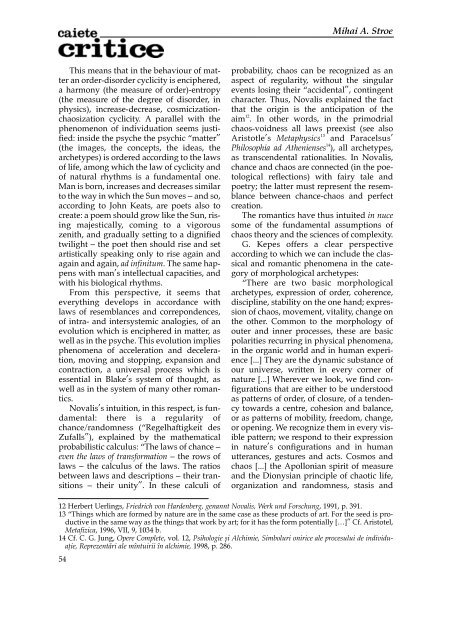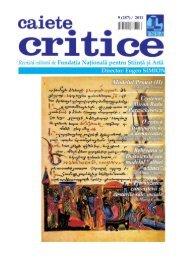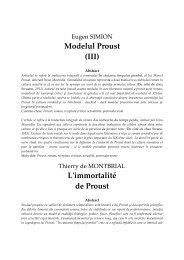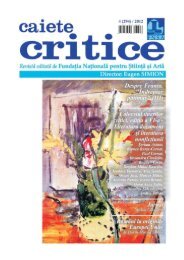Tot despre modelul grec în cultura română: parabole ... - Caiete Critice
Tot despre modelul grec în cultura română: parabole ... - Caiete Critice
Tot despre modelul grec în cultura română: parabole ... - Caiete Critice
You also want an ePaper? Increase the reach of your titles
YUMPU automatically turns print PDFs into web optimized ePapers that Google loves.
This means that in the behaviour of matter<br />
an order-disorder cyclicity is enciphered,<br />
a harmony (the measure of order)-entropy<br />
(the measure of the degree of disorder, in<br />
physics), increase-decrease, cosmicizationchaosization<br />
cyclicity. A parallel with the<br />
phenomenon of individuation seems justified:<br />
inside the psyche the psychic “matter”<br />
(the images, the concepts, the ideas, the<br />
archetypes) is ordered according to the laws<br />
of life, among which the law of cyclicity and<br />
of natural rhythms is a fundamental one.<br />
Man is born, increases and decreases similar<br />
to the way in which the Sun moves – and so,<br />
according to John Keats, are poets also to<br />
create: a poem should grow like the Sun, rising<br />
majestically, coming to a vigorous<br />
zenith, and gradually setting to a dignified<br />
twilight – the poet then should rise and set<br />
artistically speaking only to rise again and<br />
again and again, ad infinitum. The same happens<br />
with man’s intellectual capacities, and<br />
with his biological rhythms.<br />
From this perspective, it seems that<br />
everything develops in accordance with<br />
laws of resemblances and correpondences,<br />
of intra- and intersystemic analogies, of an<br />
evolution which is enciphered in matter, as<br />
well as in the psyche. This evolution implies<br />
phenomena of acceleration and deceleration,<br />
moving and stopping, expansion and<br />
contraction, a universal process which is<br />
essential in Blake’s system of thought, as<br />
well as in the system of many other romantics.<br />
Novalis’s intuition, in this respect, is fundamental:<br />
there is a regularity of<br />
chance/randomness (“Regelhaftigkeit des<br />
Zufalls”), explained by the mathematical<br />
probabilistic calculus: “The laws of chance –<br />
even the laws of transformation – the rows of<br />
laws – the calculus of the laws. The ratios<br />
between laws and descriptions – their transitions<br />
– their unity”. In these calculi of<br />
54<br />
Mihai A. Stroe<br />
probability, chaos can be recognized as an<br />
aspect of regularity, without the singular<br />
events losing their “accidental”, contingent<br />
character. Thus, Novalis explained the fact<br />
that the origin is the anticipation of the<br />
aim 12 . In other words, in the primodrial<br />
chaos-voidness all laws preexist (see also<br />
Aristotle’s Metaphysics 13 and Paracelsus’<br />
Philosophia ad Athenienses 14 ), all archetypes,<br />
as transcendental rationalities. In Novalis,<br />
chance and chaos are connected (in the poetological<br />
reflections) with fairy tale and<br />
poetry; the latter must represent the resemblance<br />
between chance-chaos and perfect<br />
creation.<br />
The romantics have thus intuited in nuce<br />
some of the fundamental assumptions of<br />
chaos theory and the sciences of complexity.<br />
G. Kepes offers a clear perspective<br />
according to which we can include the classical<br />
and romantic phenomena in the category<br />
of morphological archetypes:<br />
“There are two basic morphological<br />
archetypes, expression of order, coherence,<br />
discipline, stability on the one hand; expression<br />
of chaos, movement, vitality, change on<br />
the other. Common to the morphology of<br />
outer and inner processes, these are basic<br />
polarities recurring in physical phenomena,<br />
in the organic world and in human experience<br />
[...] They are the dynamic substance of<br />
our universe, written in every corner of<br />
nature [...] Wherever we look, we find configurations<br />
that are either to be understood<br />
as patterns of order, of closure, of a tendency<br />
towards a centre, cohesion and balance,<br />
or as patterns of mobility, freedom, change,<br />
or opening. We recognize them in every visible<br />
pattern; we respond to their expression<br />
in nature’s configurations and in human<br />
utterances, gestures and acts. Cosmos and<br />
chaos [...] the Apollonian spirit of measure<br />
and the Dionysian principle of chaotic life,<br />
organization and randomness, stasis and<br />
12 Herbert Uerlings, Friedrich von Hardenberg, genannt Novalis, Werk und Forschung, 1991, p. 391.<br />
13 “Things which are formed by nature are in the same case as these products of art. For the seed is productive<br />
in the same way as the things that work by art; for it has the form potentially […]” Cf. Aristotel,<br />
Metafizica, 1996, VII, 9, 1034 b.<br />
14 Cf. C. G. Jung, Opere Complete, vol. 12, Psihologie ºi Alchimie, Simboluri onirice ale procesului de individuaþie,<br />
Reprezentãri ale m<strong>în</strong>tuirii <strong>în</strong> alchimie, 1998, p. 286.







